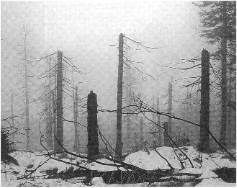| Sulphur Oxides |
|
These are the second most common urban air pollutants, the table below indicates the sulphur content of a range of fuels and hence the major source of sulphur as a pollutant in the environment. Another source, producing approximately 15 to 20% of sulphur dioxide emissions, are metal smelters. This happens because many metals are present in ores as sulphur containing compounds. |
|

Acid rain damage in a forest in the Czech Republic |
|
In humans sulphur dioxide gas reacts with moisture in the eyes,
lungs, and other mucous membranes forming strongly irritating
acid which can aggravate already existing respiratory or heart
disorders. It can also trigger allergic reaction and asthma in
sensitive individuals.
Sulphur dioxide is also damaging to plants causing leaf necrosis, but the major concern centers on its ability to form droplets of sulphuric acid (aerosol), in this form 0it can travel long distances through the air or deep into the lungs where it is very damaging. It is estimated that sulphate particles and droplets reduce air visibility by as much as 80% over much of the U.S.A. |